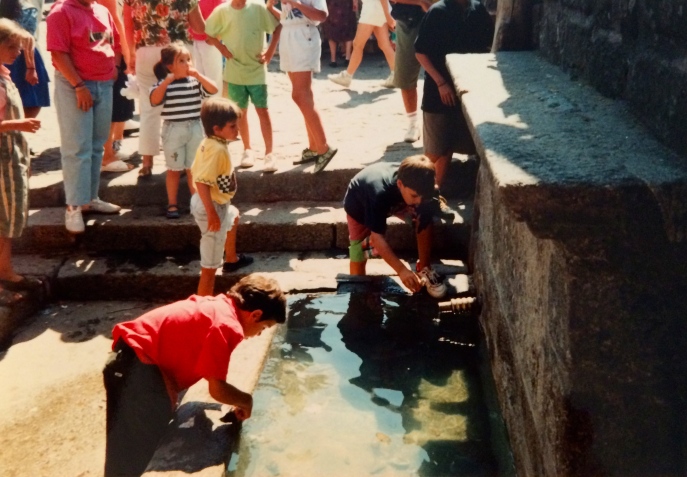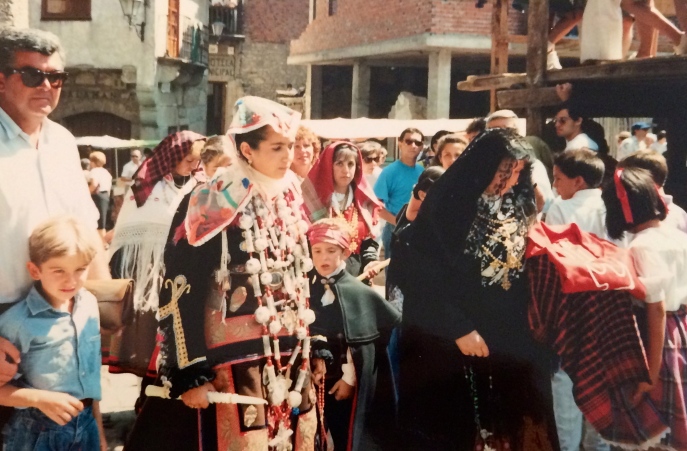[The story thus far: In the summer of 1990, I left the United States for the first time in forty years on an inexpensive two-week tour for older travelers sponsored by the University of New Hampshire. “Inexpensive” was key for me — which explains why the destination was Salamanca, Spain, the hotel had only one star, the food was unhealthy and unexciting, the program had twenty-eight participants (too many) and I agreed to share a room with a stranger. It wasn’t all a disappointment though. R., my luck-of-the-draw roommate, turned out to be terrific. And during that first trip I learned what I liked when traveling and what I didn’t. The pictures that follow are not good. They were taken by an extremely inexperienced photographer (me) with a small automatic camera on film that passed through customs x-rays twice, albeit in a lead-lined bag, and then was developed without instruction by sending it out through a drug store back home. I couldn’t crop, brighten, or edit. So what you see is what I got. But for me, anyway, these prints certainly bring the trip back. Which, aesthetics aside, is what vacation pictures are supposed to do, no?]
Because a university had sponsored the trip, there was necessarily an educational component to this vacation, which I could have done without. After all, I had already had twenty-two years of schooling, not counting nursery school and kindergarten. Nevertheless, for the first three or four days our mornings began after breakfast in a classroom: teacher, blackboard, pointer, the works. Here is “Professor Nena Lucas, N.A.” telling us what she and the colegio for which she worked thought we ought to know before we actually saw anything. Her English was reasonably fluent but heavily accented. She was twenty-six, married with two small children, and earning summer money to finish her doctorate. She was dedicated to her job with us:
I liked her. I really did. She worked so hard. But you can tell from the picture I took that I sat in the rear of the room. You also can tell from the blur what an amateur photographer I was. Anyway. Salamanca is the capital of the Province of Salamanca in the Community of Castile and Leon [in northwestern Spain]. Its Old City was declared a UNESCO Heritage Site in 1988. It is the second most populated area in Castile and Leon after Vallodolid, and ahead of Leon and Burgos. 16% of Spain’s market for Spanish language study is here. It has lots of iglesias (cathedrals and churches), conventos (convents) and a Roman bridge of which fifteen arches date from the first century B.C. That’s the kind of information Professor Nena was there to provide. She also offered a brief overview of Spanish history — tactfully omitting Franco, under whose regime she must have grown up — Spanish economics, art and literature. I confess I remember none of it and just now paraphrased Wikipedia to give you an idea of what our first few mornings on the tour were like.
I counted four unattached men among the twenty-eight participants. It later turned out one of them had brought his girlfriend along so he was already part of a couple. There were also perhaps five married couples, of assorted ages but all over fifty. That left about eleven unattached women — nine if you subtract R. and me. Of the three “available” men, the one in the picture on the left worked in a monastery as a lay clerk and was with us for the religious experience, and also to improve his Spanish. Another (face hidden in picture on right) had gone on every tour the University of New Hampshire ever offered and was still unattached, which might tell you something. Then there was W., also on the right, checking me out instead of paying attention to Professor Nena. Boy, was he busy during his twelve tour days fending off attention from women, visibly playing them off against each other and loving it. Conclusion: Do not sign up for older-traveler tours to meet men! Mr. Right — or even Mr. Acceptable — generally doesn’t go for this kind of thing alone.
After the lectures, we were free to roam. There was the bridge, the two main cathedrals — old and new — and the University to see. [Shot of University at top of post.] That University, which dates from 1136, is the oldest in Spain, the fourth oldest in Europe and remains an important center of learning. A few parting words, though, about the “educational” component of non-specialized tours. (I exempt specialized programs specifically focussed on architecture, or horticulture, or Great Homes of England, or like that.) Even before the Internet, we could have found everything Professor Nena had to say in a guide to travel in Spain, and I wish the program had provided recommended preliminary reading for those who signed up and cut the “colegio” hours. It would have left more time for looking, which is what most of us, except perhaps the monastery guy, had come to do. There’s also a lot of dead time on buses — perfect for little refresher courses on whatever we might be going to see that day.
Below is what almost all architecture in the Old City looks like to the uneducated eye. I’m sure there are important architectural differences between buildings erected in different long-ago centuries, but I couldn’t tell you what they are and I’m sure no one else on the tour could, either.)
Note that one of the real difficulties in capturing an entire significant building on an automatic camera is the inability to adjust for size. Unless I was very far away, I had to do tops, or bottoms, or a detail. (Details were usually of saints.) Hence you get only a piece of cathedral here, and only a small piece of the university up at the top of the post. On the other hand, the university courtyard — with R., the American tourist in the middle of the picture, rolled-up souvenir between her white-sneakered feet — came out much better.
The camera also worked well for city scenes:
And then we hit the road. August 15 is some sort of local religious holiday in a tiny village called La Alberca. You can reach it from Salamanca in about an hour by bus.
There’s a pageant, with traditional costumes, and people who’ve come from all around the vicinity to see the show.
But the part of La Alberca I liked best was in the countryside just behind the village. Before the bus left to take us on to Miranda del Castenar (another village), I walked back there by myself. After the tumult of the procession and its spectators, it was so peaceful, quiet and green I could have sat down beneath the trees and stayed and stayed….
Instead, I took these two photographs, which are still in my bedroom, twenty-four years later, enlarged and framed:
Miranda del Castenar is a village from another time. (Although people still live there, and have cars — which spoil the view.) I’m a sucker for places like this. It has too many steps without railings for me to think of ever, in my real life, living there. Or anywhere like it. But I do love the idea of life in an earlier, simpler time. I know, I know: a time when life was, as Hobbes famously said, “nasty, brutal and short.” But isn’t travel a form of fantasy? We can never know what it’s really like to live anywhere, unless we move there ourselves. And even then, we’re “the others.” So let me have “my” Miranda del Castenar — stage set for a daydream about long ago.
But you must be tired by now. That was a lot of sight-seeing for one time. I’m tired too. (I’m not so deft at uploading photos and inserting them where I want them in a post.) So I think I’ll call it a day and try to finish up next time. Or the next two times. ( I do tend to run on.)
[To be continued]
























Brings back memories for me, too. I spent a year in Cartagena, in the south of Spain, way back in 1965-66.
LikeLike
Almost half a century. That IS a long time ago. Although living in a place for a year is a totally different experience than twelve days of bus-ing around. Do you have pictures? I know that’s not your usual sort of post, but it would be interesting to read your (illustrated?) reminiscences. 🙂
LikeLike
I never liked going on organized tours, but I do think you can meet very congenial people when you take part in activities that really interest you. There were so many things you mentioned in this post that provoked responses… I could write a lot. But don’t think it would be proper to write a comment as long as the post. Thanks for the story, though. I enjoy your memories very much.
LikeLike
Maybe you could comment on just one of the “many” things? But if not, thank you anyway, so much, for your appreciation.
LikeLike